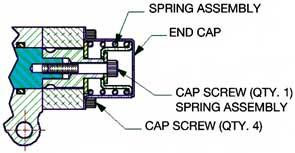Logsplitter Safety
Improper plumbing of a Cross control valve to a logsplitter may result in accidental activation of the cylinder ram resulting in serious personal injury or possible death. This risk can be avoided by plumbing and maintaining the Cross valve in accordance with these directions.
The following are the only two installations recommended by Cross Manufacturing Inc. for this valve.
DO NOT use Teflon Tape use liquid pipe sealant only.
1. STANDARD HANDLE BRACKET MOUNTING. The valve is mounted so the handle is on the cylinder base end as shown. Push handle IN. Valve spool moves IN, pressurizing port on handle end. Cylinder extends to split log.

2. INVERTED HANDLE BRACKET. Pull handle OUT. Valve spool moves IN, pressurizing port on handle end. Cylinder extends to split log.

THE OIL FLOW WHICH STROKES THE CYLINDER IN THE LOGSPLITTING DIRECTION MUST COME FROM THE VALVE PORT CLOSEST TO THE HANDLE - "A" PORT. "A" port should always be plumbed to the base of the cylinder. Oil is supplied to this port by shifting the valve spool IN as noted in the above installations.
In reference to these installations, the only recommended spool action options are:
- Three position spring centered spool - SPOOL ACTION "A"
- Pressure release detent from spool OUT position only - SPOOL ACTION "F" (A logsplitter valve should NEVER be detented in the forward position or while the cylinder is extending. Any detent in this position is a great health and safety hazard to the operator.)
- Spring extended spool, no neutral - SPOOL ACTION "R'" (May cause overheating if a fixed displacement pump is used.)
The cap screw which holds the spring assembly under the end cap to the spool is treated with a chemical adhesive and properly torqued when the valve is assembled at the factory. Under extreme vibrating conditions or from improper torque after field repair to the valve, it is possible for this cap screw to work loose. This will created NEUTRAL SLACK of the valve spool.
This neutral slack will allow the spool to move outward the same distance that the cap screw backs off. If this movement is far enough, oil will flow from the valve port furthest from the handle ("B" port) causing the cylinder to stroke in the direction this port is plumbed to. If the "B" port is plumbed to the splitting stroke side of the cylinder, it could be a safety hazard to the operator. The cylinder could stroke forward unexpectedly if the valve spool floats out because of the neutral slack. For this reason Cross recommends that the "B" port NEVER be plumbed to the base or splitting side of the cylinder.
When the valve is plumbed properly as described in the diagrams on the previous page, spool shift outward to the neutral slack will cause the cylinder to retract away from the log. For proper logsplitter performance and maximum safety, however, the operator should be aware of the possibility of neutral slack.
If neutral slack occurs, you should shut the logsplitter down, remove the valve end cap by removing the cap screws (4). Remove the spring assembly cap screw (1) shown in the illustration and apply locking adhesive to the thread. Reinstall this cap screw and tighten to 9-11 foot pounds of torque. Replace the end cap and the remaining 4 cap screws which should also be torqued to 9-11 foot pounds.
"SPOOL ACTIONS" refer to ordering information in Cross catalogs. See FM VBA1 and VCA1





